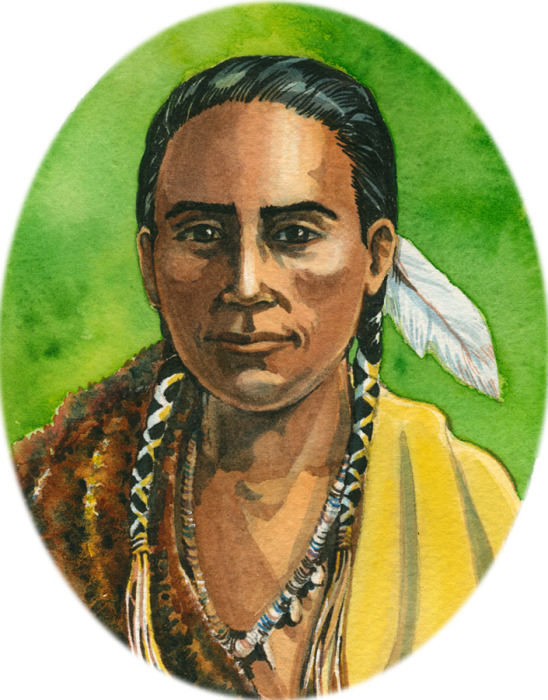Tisquantum was a native of Patuxet, living at present-day Plymouth; the Patuxet belonged to the Wampanoag confederation of tribes. Nothing is really known about Squanto's early life. His history picks up in 1614, when Captain John Smith and some of other ships under his command arrive to map Cape Cod and vicinity. John Smith is perhaps better known for having been rescued by Pocahontas at the Jamestown Colony several years earlier. After Smith completed his exploration and mapping of the harbors, he departed, leaving behind an associate, Captain Thomas Hunt, to trade with the Indians. John Smith had hopes of founding a plantation in New England, and so wanted to engage the Indians in trade.
Thomas Hunt, however, had other plans. Offering to trade beaver, Hunt lured 24 Nauset and Patuxet Indians onboard his ship and took them captive. John Smith would later write that Master Hunt "most dishonestly, and inhumanely, for their kind usage of me and all our men, carried them with him to Malaga, and there for a little private gain sold those silly salvages for rials of eight". Sir Ferdinando Gorges, head of the Council for New England, remembered it similarly: "one Hunt (a worthless fellow of our nation) set out by certain merchants for love of gain; who (not content with the commodity he had by the fish, and peaceable trade he found among the savages) after he had made his dispatch, and was ready to set sail, (more savage-like than they) seized upon the poor innocent creatures, that in confidence of his honesty had put themselves into his hands."
Hunt stored the Indians below the hatches, and sailed them to the Straits of Gibraltar, and on to the city of Malaga, Spain, where he sold as many of them as he could. But when some local Friars in Malaga discovered that they had been brought from America, they took custody of the remaining Indians, and instructed them in the Christian faith. As Sir Ferdinando Gorges states, the Friars "so disappointed this unworthy fellow of the hopes of gain he conceived to make by this new and devilish project."
The Nauset and Patuxet tribes were outraged by the kidnappings, and became extremely hostile. English and French ships visiting Plymouth and Cape Cod were no longer welcomed with profitable beaver trade, as an unwitting French captain and crew would discover in 1617, when their ship was burned and almost everyone killed (a few were enslaved) by the Nauset.
But outrage against Europeans would soon become a low priority amongst the Nauset and Patuxet. In 1618 and 1619, a devastating plague, described variously in historical sources as either tuberculosis or smallpox (and perhaps a combination of both), wiped out the entire village at Patuxet, and many surrounding areas were heavily hit.
One Patuxet did survive, however: Tisquantum. He had somehow found himself passage from Malaga, Spain into England, where he began living with John Slaney in Cornhill, London, and began picking up the English language. John Slaney was the treasurer of the Newfoundland Company which had managed to place a colony at Cupper's Cove (Cupids), Newfoundland in 1610; he employed Tisquantum, presumably as an interpreter and as an expert on North American natural resources. He was sent to Newfoundland, and worked there with Captain John Mason, governor of the Newfoundland Colony.
While in Newfoundland, Tisquantum encountered a ship's captain by the name of Thomas Dermer, who had worked with Captain John Smith, perhaps even on the 1614 mapping expedition in which Squanto had been originally taken. Dermer was employed by the New England Company, headed by Sir Ferdinando Gorges; they still had hopes to profit from beaver trade with the Indians of Massachusetts: but this would not be possible as long as hostilities remained. Thomas Dermer recognized that Tisquantum, who had now been living with Englishmen for a number of years, could act as an interpreter and peacemaker between the English and the still-enraged Indians of Patuxet and Nauset. He sent a letter off to Sir Ferdinando Gorges expressing the good use Tisquantum could be put to, and Gorges had them come back to England to discuss their plans.
The Pilgrims lived out of the Mayflower, and ferried back and forth to land to build their storehouses and living houses: they labored all through the winter months of December, January, February, and didn't start moving entirely to shore until March. And during that entire time, they saw almost no signs of any Indians, aside from a few fires burning in the far distance. On March 16, they got a surprise: an Indian named Samoset walked right into the Colony and welcomed them in broken English. Samoset was from an Indian group in Maine, and had picked up a few English words from the fisherman that came into the harbors there. He informed them there was an Indian, Tisquantum, who had been to England and could speak better English than he could. Tisquantum made his first appearance on March 22, at which time he brought Massasoit and Quadequina. The Pilgrims used the opportunity to negotiate a peace treaty and to establish trading relations.
-- from Mayflower History
TIME TRIP ADVENTURE 4
KILLING FOR COUNTRY
TIME TRIP ADVENTURE 2
A RIDE ON THE UNDERGROUND RAILROAD
TIME TRIP ADVENTURE 3
WITNESS TO THE FIRST THANKSGIVING




No comments:
Post a Comment
Thank you for submitting a comment. We will review and post your comment as soon as possible.